Learn how to get great butterfly images. Find out what camera equipment you will need and the photo techniques used for capturing beautiful butterfly photos in a Butterfly House.
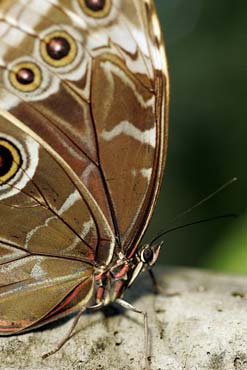
Copyright © Andy Long
Common Blue Morpho –
Morpho peleides
Come in tight to show just a part of them.
It’s a cold winter day, and you want to get some photography done–but not in the chilly weather outside. What to do? If you live in one of the twenty states with a butterfly house, head there for a couple of hours of interesting shooting. The types of butterflies you’ll find will vary in species, size, and color with the time of year, but you’re certain to have plenty of subjects. While you can capture a great butterfly shot outside during the summer months, chances are, the best shots will still happen at one of these built-in rain forests.
Be ready for a fogged lens when you first enter, but after you get rid of that inconvenience, the fun begins. One way to get your camera ready on the way to one of these warm, humid butterfly zoos is to turn the heat on in your vehicle and put the lenses on the floorboard to warm them up. Putting them in Ziploc bags and then keeping them in there for a little bit when you first arrive in the room can also be helpful. More than likely, they’ll fog at some point, anyway, so bring along a lens cloth to wipe them off from time to time.
If you don’t live near one of the butterfly aviaries in the country, visiting a botanic garden during the summer can also produce good opportunities to create butterfly images. No matter where you go, get there early in the morning, as these beautiful creatures are much less active early in the day before they warm up and begin going from flower to flower to gather nectar. Even then, if you notice one flower that’s getting a lot of activity, you can stay there and wait for the butterflies to come to you.

Copyright 2007 Andy Long
Great Mormon – Papilio memnon
If you see a spot where numerous butterflies are landing, set yourself up and wait for one.
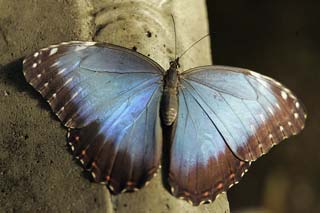
Copyright 2007 Andy Long
Common Blue Morpho –
Morpho peleides
Look for the colorful ones and wait for them to open their wings.
Another reason for arriving when the doors to the botanic gardens or butterfly aviary open is you’ll have time alone before the crowds arrive. If you go on a Saturday, expect to share the space with families bringing their young children for a fun outing. They typically don’t show up for about an hour after the facility opens. However, going during a work week doesn’t guarantee you’ll have lots of space, either, because many butterfly aviaries have programs in which the schools in the area bring groups of students throughout the year. Making a simple call to the facility ahead of your visit to find a morning when no tours are scheduled would be best.
Most butterfly aviaries have species from all over the world. It’s almost like taking a trip to a Costa Rican rainforest where you would discover more butterfly species than almost anyplace else. However, because some of your subjects will be unique species, identifying them can be a challenge. There are several websites that have identification information, and you can locate identification books, as well. An easy shortcut idea is to find a volunteer/employee who is walking around the facility when you’re shooting, have him tell you what the different individuals are, and write their names down.
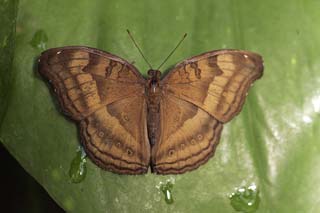
Copyright 2007 Andy Long
Chocolate Pansy – Precis iphita
You have to look all over the place to find them hidden, just out of plain sight.
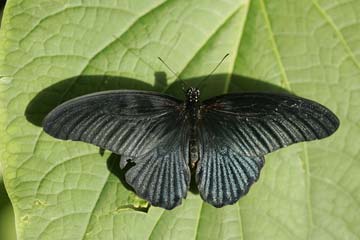
Copyright 2007 Andy Long
Great Mormon – Papilio memnon
There’s usually one part of the aviary where the windows face the sun and it usually attracts a lot of butterflies, so they can warm up.
EQUIPMENT
- While monopods are allowed in butterfly aviaries and in the wild, they rarely work because they’re never set at the height you need. So, handholding is pretty much the only way to go when photographing butterflies–no matter where you are.
- As for lenses, a macro is the best option. Depending on your preference, you can use auto-focus, but sometimes you’ll want to manually focus on a part of a butterfly to make sure it’s in focus. Another lens option is a zoom in the 70-200mm range coupled with extension tubes. The tubes are a necessity, as these allow for closer focusing on the subject than you normally would get from most zoom lenses in this range.
- You’ll have shots where you need a flash, and shots where you won’t. In most aviaries, there’s usually one area where there’s plenty of light shining in through the window. At this spot, a flash isn’t necessary. In other spots, a flash will come in handy.

Copyright 2007 Andy Long
Western Meadow Fritillary (taken in the wild)
You can get images of butterflies in the wild, but it can be difficult and it doesn’t occur very often.
TECHNIQUES
- Because you’ll be handholding the camera and the lighting in butterfly aviaries isn’t the greatest, bumping the ISO up to the 800 to 1000 range on digital cameras is recommended to achieve a fast shutter speed.
- As far as f/stop, this can be adjustable depending on the cameras position in relation to the butterfly. If you’re able to get completely parallel with its wings, then you can open up the lens as far as it will go, so you get a fast shutter speed. If you’re not parallel, stop down a stop or two–even more if you’re using a macro lens, so there’s enough in focus to produce a usable image. (Instead of opening up all the way, I always stop down at least ½ stop–to give a little more depth of field.)
- For the flash, use TTL but also set the exposure to about –1. This way, too much light won’t blow out the highlights of the subject or the background, especially if it’s a reflective green leaf. The flash can be mounted atop the camera body, on a bracket off to the side, or (using a cable) held wherever you think the best light angle will be.
- Watch the background. There are places where the butterflies land that might have light coming in through the windows. These are places to avoid when you’re shooting, as the bright light will be a distraction on the image.
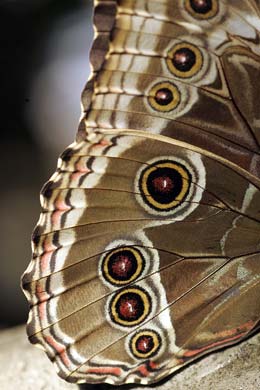
Copyright © Andy Long
Common Blue Morpho –
Morpho peleides
The patterns and details of the wings can be quite interesting & beautiful.
Like all wild animals, even among different species, butterflies have a comfort zone as to how close they allow people to be to them. But, if it’s early in the morning and they aren’t fully awake, you can move quite close. (One butterfly permitted me to be only inches away from him, letting me get some tight shots of the detailed patterns on its wings.)
Try shooting lots of different images of these beautiful flyers. Watch for places different ones are landing somewhat frequently, stay there, and let them come to you. Look for interesting flowers they’re using that create a nice color combination, or broad leaves they tend to land on near a window to warm up. You’ll really have to look hard to find some of them, though, as they tend to blend into their environment. A camouflaged shot can make for an interesting composition.
You’ll probably throw away more photos than you keep your first time out, but if you come to enjoy doing this and go back several times a year, you’ll learn the nuances of taking their pictures and end up with more keepers as time goes on. No doubt, if you go one time, you’ll end up wanting to go back again.
by Andy Long

Where are all of these 20 Butterfly Houses?